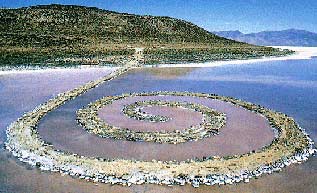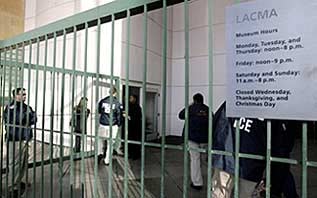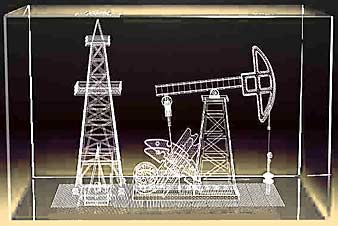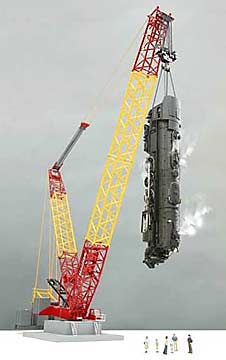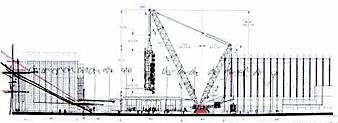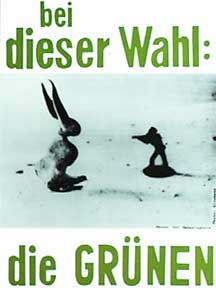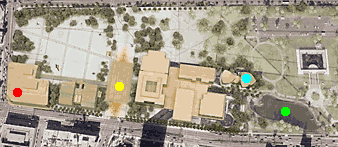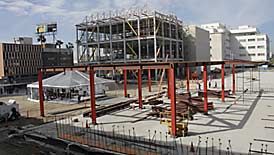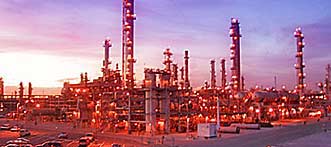LACMA’s $25 Million Choo-Choo Train
In my April 2007 article, Jeff Koons: The Schlock of the New, I detailed the collaboration between LACMA and Koons when it was merely at its formative stage. At the time, the Annenberg Foundation provided LACMA and Koons with funds for engineering studies concerning the feasibility of such an edifice. As it turns out, The Art Newspaper reported; "LACMA has already spent about $1.75 of $2 million pledged by trustee Wallis Annenberg for preliminary studies." In my '07 article I wrote:
"Those who attempt to find anything meaningful in Koons' productions should simply remember the following admonition from him, 'A viewer might at first see irony in my work... but I see none at all. Irony causes too much critical contemplation.' There you have it, the perfect art for 21st century America - it won’t make you think!Modern art enthusiast and critic, Waldemar Januszczak, wrote an article for the TimesOnline of the U.K., in which he describes his waning love affair with postmodern art. He was specifically writing of the U.K’s conceptual Young British Artists and the Tate Modern, but his words can just as easily apply to LACMA, Koons, and postmodern art in general. Significantly, Januszczak took great pains in his article to describe himself as a booster of contemporary art, writing that "it’s been my life, my career, my sustenance" and that when he offers a critique - "you can be confident it’s serious." Januszczak wrote:
(....) Koons supposedly represents the 'best and brightest' from the national cultural scene - a sad 'fact' I find utterly disheartening and unacceptable. That LACMA can reward this cipher with a high-profile commission and a place in art history does not bode well for any of us. Robert Pincus-Witten, director of exhibitions at C&M Arts, put it this way; 'Jeff recognizes that works of art in a capitalist culture inevitably are reduced to the condition of commodity. What Jeff did was say, 'Let’s short-circuit the process. Let’s begin with the commodity.'
In other words - to hell with art, let’s make money."
"What we have here today is a situation that parallels events in France in the 1860s, when the Paris salon became too powerful and the impressionist revolt needed to happen to revive art. The Tate is the salon of today: pompous, arrogant, all-powerful and utterly convinced of its superiority. What began as a force for progress and coherence has turned into a cultural despot that has the government’s ear.It is entirely appropriate for Januszczak to compare today’s postmodern art elites with the entrenched French Academy of the 1860s and its attempts to suppress Impressionism. But LACMA’s patronage of Koons reminds one not so much of the French Salon as it does the insensitivity and pitilessness of France’s Ancien Régime just before it was overthrown by the revolution of 1789. At the same time as American museums layoff staff and cancel exhibits, as galleries go out of business and artists struggle to stay alive, while millions across America lose their jobs, homes, or both - LACMA fritters away tens of millions on what can only be seen as a monument to triviality. How many thousands of artists could LACMA commission with $25 million? How many art workshops could it subsidize in underserved communities? Let them eat cake indeed.
(....) Just as the Paris salon favoured the conceptual over the actual - pretentious history painting over vivid snapshots of everyday life - so the Tate supports art that imagines it is on a higher plane than the everyday."
On March 4, 2009, the National Endowment for the Arts released the results of its research on artist unemployment rates, a report that concludes joblessness is not only skyrocketing for artists, but that the artist workforce has "contracted" and that "artists are unemployed at twice the rate of professional workers." The NEA found that in the fourth quarter of 2008, some 129,000 artists were unemployed nationally, a 63% increase from the previous year. While the NEA report did not give a state-by-state breakdown on unemployment rates for artists, a previous NEA study found that more artists live in California than in any other state of the union (some 140,620 working artists), even ranking above New York, which came in fourth. It is therefore not unreasonable to surmise that there are huge numbers of artists now unemployed in the state of California.
According to the National Assembly of State Arts Agencies, California is presently last when it comes to contributing to arts funding. The national average for state arts funding comes to $1.35 per capita - but California’s funding for the arts comes to a trifling 15 cents per citizen each year. The California Arts Council (CAC) is the state’s arts policy-setting agency, administering grant programs and directly supporting arts programs for all of the state’s citizens. It has a budget of only $5.6 million to administrate cultural affairs for the entire state of California.
A February 28, 2009 article by the Los Angeles Times reported that the unemployment rate for workers in the state of California has reached 10.1%, the state’s highest jobless rate in twenty-six years. Statistics from the Employment Development Department of the State of California show that as of January of this year, 1,954,900 Californians are out of work, with 537,000 now jobless in Los Angeles. Those are the official statistics, but how many Californians are underemployed or have simply given up looking for employment? The aforementioned Los Angeles Times piece quoted one economist as saying, "California is hemorrhaging faster than the U.S. economy."
In light of these facts, a price-tag of $25 million for the LACMA-Koons Train boondoggle verges upon lunacy, and it most assuredly is an indication of an arts institution profoundly out of touch with the realities lived by the vast majority of the working population of California and the nation. I should reiterate here that the base salary of LACMA director Michael Govan is $600,000 while the total annual compensation for a sitting president of the United States is $400,000.
Arts professionals have some soul searching to do. It is transparently obvious why a greater part of the U.S. population feels alienated from and at variance with contemporary art. In short the public’s gut reaction that art has nothing to do with them and that it is only for the privileged few, is in fact an astute observation based upon the circumstances before us. It is high time that American artists begin to create the new works and institutions that will help free the public of such an erroneous opinion.
Labels: LACMA, Michael Govan, Postmodernism-Remodernism
